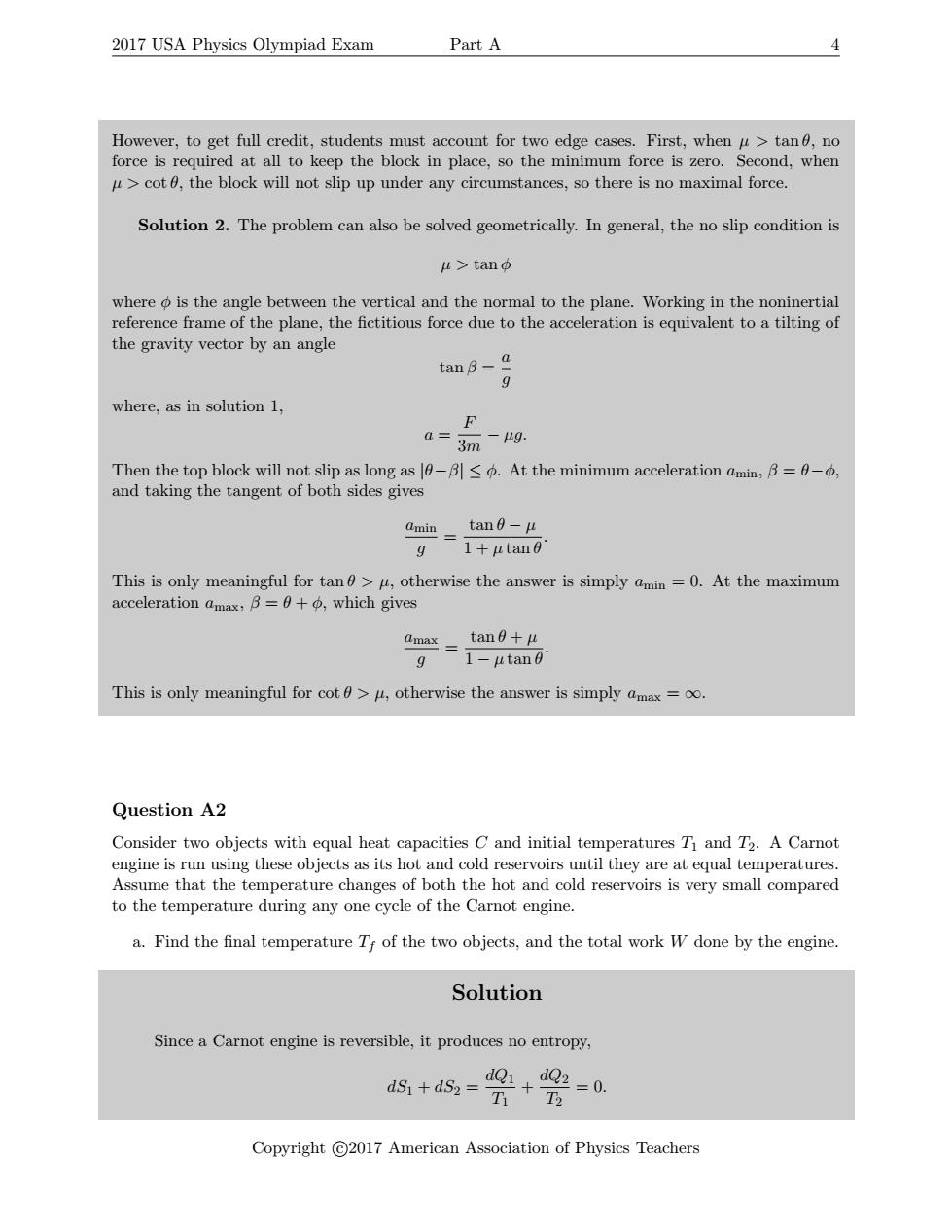正在加载图片...

2017 USA Physics Olympiad Exam Part A However,to get full credit,students must account for two edge cases.First,when u>tan,no force is required at all to keep the block in place,so the minimum force is zero.Second,when u>cot0,the block will not slip up under any circumstances,so there is no maximal force. Solution 2.The problem can also be solved geometrically.In general,the no slip condition is u>tano where o is the angle between the vertical and the normal to the plane.Working in the noninertial reference frame of the plane,the fictitious force due to the acceleration is equivalent to a tilting of the gravity vector by an angle tanB= g where,as in solution 1, F a≠3m -μg Then the top block will not slip as long as 0-B<o.At the minimum acceleration amin,B=6-0, and taking the tangent of both sides gives amin tan0-μ 9 1+utan0 This is only meaningful for tan0>u,otherwise the answer is simply amin =0.At the maximum acceleration amax,B=0+o,which gives dmax tanf+μ 9 1-utan This is only meaningful for cot 6>u,otherwise the answer is simply amax=oo. Question A2 Consider two objects with equal heat capacities C and initial temperatures T and T2.A Carnot engine is run using these objects as its hot and cold reservoirs until they are at equal temperatures. Assume that the temperature changes of both the hot and cold reservoirs is very small compared to the temperature during any one cycle of the Carnot engine. a.Find the final temperature Tf of the two objects,and the total work W done by the engine. Solution Since a Carnot engine is reversible,it produces no entropy, dS1 +ds2 d+d2=0. T T2 Copyright C2017 American Association of Physics Teachers2017 USA Physics Olympiad Exam Part A 4 However, to get full credit, students must account for two edge cases. First, when µ > tan θ, no force is required at all to keep the block in place, so the minimum force is zero. Second, when µ > cot θ, the block will not slip up under any circumstances, so there is no maximal force. Solution 2. The problem can also be solved geometrically. In general, the no slip condition is µ > tan φ where φ is the angle between the vertical and the normal to the plane. Working in the noninertial reference frame of the plane, the fictitious force due to the acceleration is equivalent to a tilting of the gravity vector by an angle tan β = a g where, as in solution 1, a = F 3m − µg. Then the top block will not slip as long as |θ−β| ≤ φ. At the minimum acceleration amin, β = θ−φ, and taking the tangent of both sides gives amin g = tan θ − µ 1 + µ tan θ . This is only meaningful for tan θ > µ, otherwise the answer is simply amin = 0. At the maximum acceleration amax, β = θ + φ, which gives amax g = tan θ + µ 1 − µ tan θ . This is only meaningful for cot θ > µ, otherwise the answer is simply amax = ∞. Question A2 Consider two objects with equal heat capacities C and initial temperatures T1 and T2. A Carnot engine is run using these objects as its hot and cold reservoirs until they are at equal temperatures. Assume that the temperature changes of both the hot and cold reservoirs is very small compared to the temperature during any one cycle of the Carnot engine. a. Find the final temperature Tf of the two objects, and the total work W done by the engine. Solution Since a Carnot engine is reversible, it produces no entropy, dS1 + dS2 = dQ1 T1 + dQ2 T2 = 0. Copyright c 2017 American Association of Physics Teachers